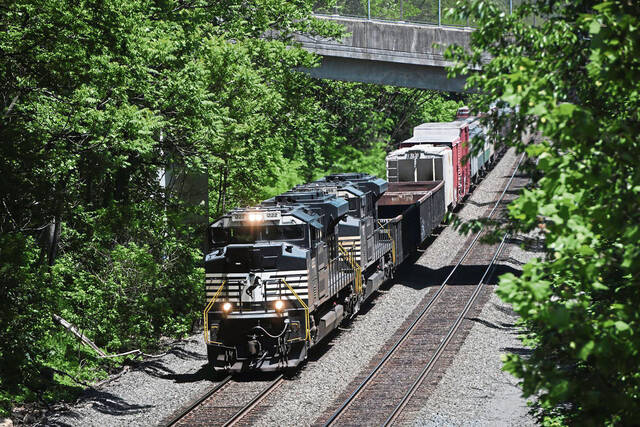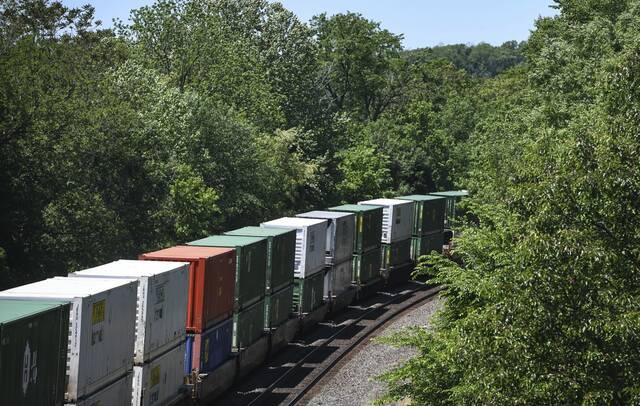Westmoreland officials talk train derailment contingency plans with expert
Since the derailment of a Norfolk Southern train filled with hazardous materials in Ohio earlier this year, the looming potential of a similar disaster has weighed heavily on the minds of local leaders whose communities are traversed by trains every day.
Thirty-eight Norfolk Southern train cars jumped the tracks Feb. 3 in the fiery wreck in East Palestine. No one was injured, but about half of the town’s population was evacuated for days after authorities ignited vinyl chloride stored in five cars to prevent an explosion. Many residents have complained of headaches, rashes and other health problems, although government officials say air and water tests have not found dangerous levels of contaminants.
Contingency plans for train derailments have become a hot topic for Diane Schaefer, manager of Youngwood borough. Trains are so commonplace in the community that the council president recently approached the fire chief for plans for the event of a derailment.
“You can drive down 119, and you can see right there past the car wash, there are trains parked there all the time,” she said. “We all have train tracks that come through our boroughs. It’s just like you didn’t think about tornadoes until the tornado touched down in Hempfield Township. We all think that’s not going to happen, but you have to be prepared for that ‘What if?’ ”
Schaefer and officials from other local communities had the chance Thursday to have a few of their questions about train derailments and hazmat protocols answered during a presentation at a Westmoreland County Boroughs Association meeting.
Christopher Tantlinger, chief of the county Hazmat Team 800, discussed the stages of a response to a derailment and shared his own years of experience with incidents similar to East Palestine and beyond.
“All 65 municipalities should have an emergency operations plan, and they should have a consideration of what they are going to do if something happens,” said Tantlinger, who also is the county’s deputy emergency management coordinator. “We try to work through that through the pillars of incident management. Whether it’s preparedness, planning, mitigation, recovery, all of those things, we’re trying to keep that cycle of emergency concern in the best way for you to be able to manage it.”
Response to situations
Tantlinger has been a firefighter for 30 years, in hazmat for 18 years and has worked in Ligonier Borough and Greensburg. He cited past train derailments he and his team have responded to in Hempfield and Vandergrift and shared details of the outcomes.
“The fire department and the police usually (are there) in five minutes. Then, hazmat is usually about 15 to 20 minutes,” he said. “We try to be anywhere; we have trucks and have someone anywhere in the county within 20 minutes.”
Train derailments sometimes can pose difficulties for first responders to access, as they might not always be along easily accessible roads, he said. Situational awareness and finding out what is going on are key.
“Gain response status: Are you able to handle it, or are you not able to handle it?” he said. “Once you answer that question, you know what you have to start doing.”
Tantlinger shared examples of statements that townships can disseminate to the public about an incident, as well as sample evacuation or shelter-in-place letters.
“My idea here was to try and give you an idea on what hazmat and emergency management would do if there is a train derailment, and what is going to happen, and how we can help,” he said.
Prepping for the worst
Scottdale Councilman Andy Pinskey said having a conversation with Tantlinger offered him and other borough officials some peace of mind.
Train safety is very real for Scottdale residents, he noted. Three of the town’s major arteries cross over a train track. He has talked with the local fire department about preparing potential areas where people could shelter in the case of a disaster.
“It’s a major concern for us,” he said. “Whenever all of this was happening with the derailments, I’m on our protection committee, and we talked about it there.”
Ken Phillabaum, a councilperson from Mt. Pleasant, asked Tantlinger questions about more specific details of disaster response as it applied to his borough.
“This is better than just hitting Google,” he said. “You get the actual answers instead of just going on goose chases that could end up everywhere and anywhere.”
Residents in Mt. Pleasant were interested in how response officials find out what is being hauled by a train. Tantlinger noted that in the event of a derailment, officials have access to a mobile app database they can use to cross-reference the numerical codes on the side of train cars to determine what is in them.
“For response, we can put in the rail car number,” Tantlinger said. “When you think about it, seconds and minutes can mean a lot.”
Julia Maruca is a TribLive reporter covering health and the Greensburg and Hempfield areas. She joined the Trib in 2022 after working at the Butler Eagle covering southwestern Butler County. She can be reached at jmaruca@triblive.com.
Remove the ads from your TribLIVE reading experience but still support the journalists who create the content with TribLIVE Ad-Free.



